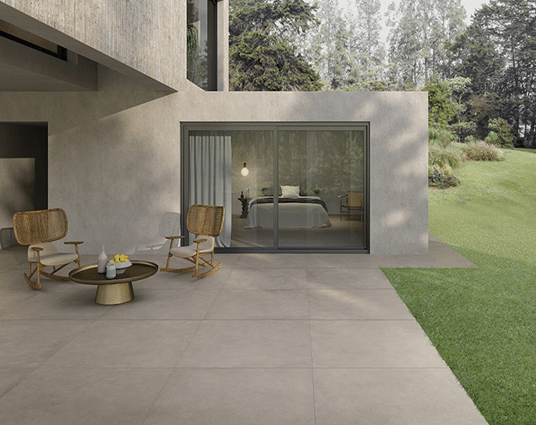Table of Contents
Contemporary architecture embraces the idea that outdoor spaces are not separate from interiors – they are extensions of the same design language. Gardens, terraces, patios, and courtyards are no longer treated as afterthoughts but as key areas that demand the same conceptual and aesthetic attention.
At the foundation of this shift is the surface underfoot. Far beyond its functional role, outdoor flooring becomes a central design tool. Among the materials available, porcelain tiles stand out for their ability to combine performance with expressive freedom, making them a true creative medium in open-air architecture.
The ground as a narrative surface in open-air architecture
In the context of outdoor design, the ground becomes a narrative surface – an element that tells a story through layout, color, and rhythm. Porcelain tiles offer architects and designers the freedom to “draw” space with intention. Through the careful selection of formats, patterns, and installation techniques, a surface can guide the eye, organize flow, or establish boundaries.
Whether creating a sense of calm continuity or a bold graphic statement, flooring defines the structure and identity of the space. Large-format slabs, geometric modules, or staggered layouts can be used to shape terraces, define zones, or visually connect different areas within a garden or courtyard.
Material integrity: bridging nature and design
Porcelain outdoor tiles bring a refined interpretation of natural materials – such as wood, marble, stone, and concrete – into the realm of architectural design. This fusion allows outdoor spaces to strike a balance between authenticity and innovation.
While traditional materials may age unpredictably or require constant care, porcelain tiles offer visual realism with superior technical performance. Their low porosity, resistance to weathering, and color stability over time make them the ideal link between architectural form and natural surroundings. They do not imitate – they interpret, elevating the material experience while respecting the integrity of the landscape.
Continuity, contrast, composition: porcelain as design language
A powerful element in spatial design, porcelain flooring allows for continuity or deliberate contrast. In projects that blur the boundaries between interior and exterior, using the same tile indoors and out can create visual flow and harmony. Alternatively, designers may choose to introduce contrast – subtle or pronounced – through changes in tone, texture, or pattern, using flooring to highlight transitions, frame features, or direct movement.
Each decision becomes a compositional gesture. Outdoor areas are no longer just functional – they are spatial compositions where the floor grounds the architectural language and expresses its intent.
Shaping experiences: outdoor flooring beyond functionality
Outdoor porcelain flooring does more than define space – it enhances the experience of being within it. Textures provide tactile feedback, grip ensures safety, and surfaces respond to light, casting shifting patterns and reflections throughout the day.
A poolside area may call for a soft-touch matte finish that is cool underfoot, while a raised garden path benefits from grip and structure. Every choice contributes to how the space feels, functions, and invites interaction. The tile becomes a sensory element – silent, but never passive – actively shaping how the user perceives and enjoys the environment.
A new design consciousness starts from the surface
In the architecture of the open air, the surface is no longer a backdrop – it is a protagonist. Porcelain flooring serves not only as a durable base but as a refined, expressive tool that influences mood, movement, and meaning. Used with creativity and purpose, it defines the very quality of the outdoor experience. Because in the most thoughtful designs, it’s not just about what surrounds us – it’s about what grounds us.
From idea to surface: how Ceramiche Keope transforms design into matter
With its roots in Italian ceramic craftsmanship and a forward-thinking industrial culture, Ceramiche Keope has become a leading force in the evolution of porcelain stoneware. Since 1995, the company, part of the Concorde Group, has pursued a clear objective: to create surfaces that express a refined sense of design while meeting the highest technical standards.
Every collection is the result of a meticulous process in which materials, textures, and formats are studied to offer not just aesthetic solutions, but design tools capable of shaping architectural identity. This approach is visible across the entire product range.
Whether intended for interiors or exteriors, each tile is engineered to support the creation of continuous, coherent spaces. The brand’s stylistic versatility is matched by functional depth: collections span marble, stone, concrete, wood, and metal effects, offering designers the freedom to interpret space in ways that are both expressive and precise. Formats, finishes, and thicknesses are conceived to ensure flexibility and harmony, from living rooms to lobbies, spas to rooftop terraces.
The outdoor collections, in particular, reflect this synthesis of performance and design culture. Resistant to extreme temperatures, thermal shock, and frost, these tiles offer long-term durability without signs of wear. Their R11 non-slip finish ensures excellent grip, minimizing the risk of slipping in wet or sloped areas.
Thanks to their low water absorption, they prevent cracks caused by freezing, while their UV resistance preserves color over time. Easy to clean and naturally hygienic due to their non-porous surface, Ceramiche Keope outdoor tiles offer a reliable, low-maintenance solution for a wide variety of open-air applications.
Sustainability is at the core of this vision. The company operates a closed-loop production process that recycles water, reintegrates raw residues, and recovers fired ceramic waste. Over 75% of its energy needs are met through self-generation, with the rest sourced exclusively from certified renewables.
Recognized by international certifications such as ISO 17889, the WELL Building Standard V2, and Declare, Ceramiche Keope’s surfaces embody a responsible, future-focused approach to materials – designed to support spaces that are not only beautiful, but also healthy and enduring.


